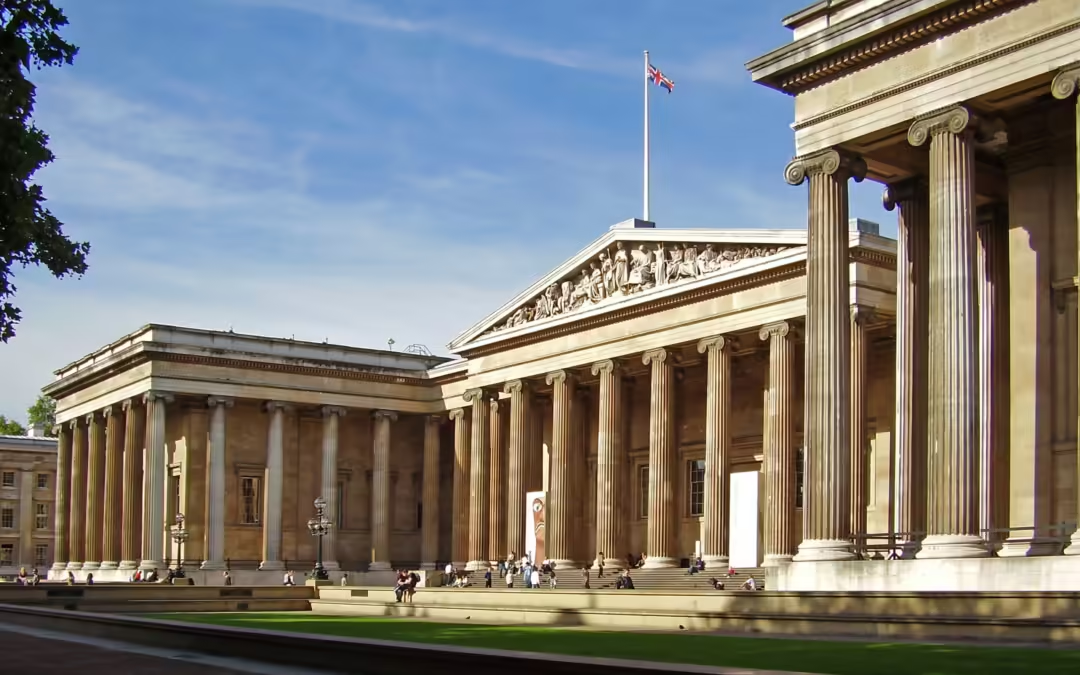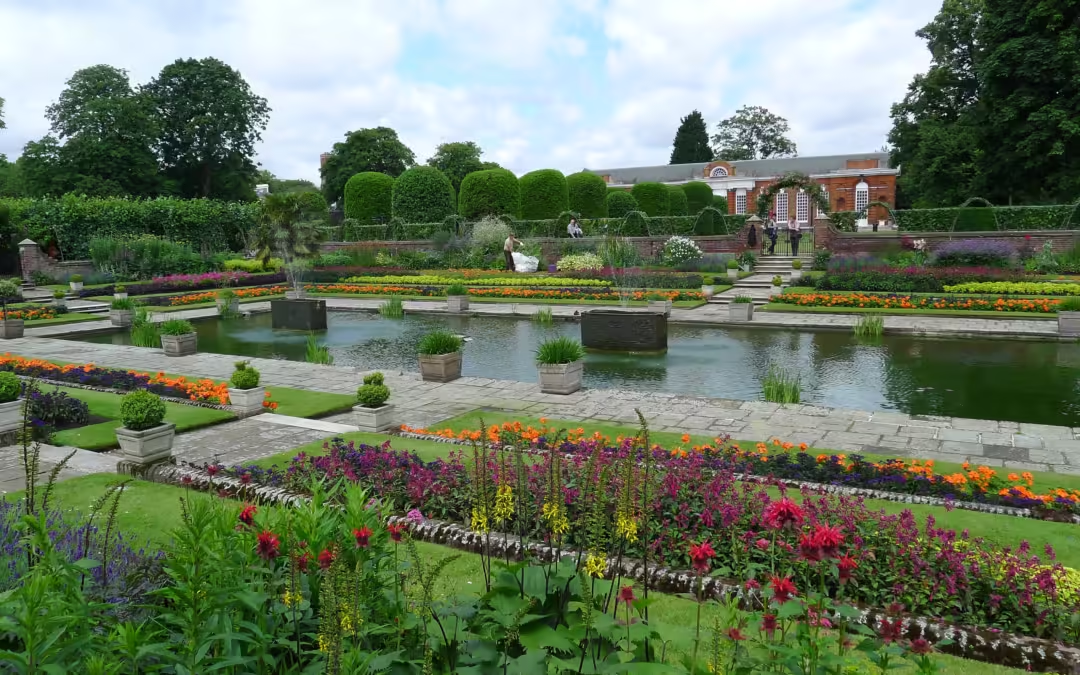
Entering the British Museum: A Grand Welcome Awaits
As you approach the British Museum, its neoclassical design and towering columns create a lasting first impression. Standing before the massive doors, you’re met with an air of history, like stepping into a portal that leads back through time. Once inside, the spacious Great Court opens up beneath a glass roof, flooded with natural light and buzzing with anticipation.
These grand halls are vast, their architecture a marvel in itself, adding a sense of awe as you prepare to explore the treasures that lie within.
Key Highlights on Your Guided Tour
The British Museum’s guides are storytellers at heart, bringing to life the stories and mysteries behind each exhibit. Let’s walk through some of the must-see sections on a tour that covers incredible relics from every corner of the world.
1. The Egyptian Gallery – Mummies, Cleopatra, and Beliefs of the Afterlife
The Egyptian Gallery is home to some of the museum’s most iconic exhibits, from statues to ancient jewellery to the famous mummies. Encountering the mummy of Cleopatra is both eerie and fascinating – a rare look into the last days of Egypt’s Ptolemaic dynasty. Stories of Cleopatra’s life and burial practices give you an authentic glimpse into Egypt’s rituals surrounding death and the afterlife.
Beyond Cleopatra, colossal statues of Pharaoh Ramses II and intricately carved sarcophagi reveal Egypt’s ancient grandeur, while ornate burial objects reflect a society deeply focused on the afterlife.
2. The Rosetta Stone – The Key to Understanding Egyptian Hieroglyphs
No visit would be complete without seeing the Rosetta Stone. This slab, inscribed in three scripts, was the breakthrough in deciphering Egyptian hieroglyphs. Standing before it, you’ll feel the importance of this discovery, which bridged our understanding of ancient Egyptian language and culture.
3. Ancient Greece and Rome – Marvel at Myths and Marble Masterpieces
This section transports you to the world of gods, heroes, and ancient philosophers. The Parthenon Sculptures, also known as the Elgin Marbles, display the art and mythology of ancient Greece. Your guide will share stories of the gods and figures these sculptures represent, giving depth to each finely detailed statue.
The Roman exhibits continue the journey, with marble busts of emperors, intricate coins, and mosaics reflecting the authority and artistic achievements of the Roman Empire.
4. The Asian Collection – Samurai Armour, Ancient Knives, and Ceramics
Step into Asia’s past, where Japanese Samurai armour stands as a testament to a warrior culture rooted in honour. You’ll see ancient knives and iconic katana swords that were more than weapons – they symbolized status and skill among Samurai. Detailed ceramic pots used for water and tea storage add another layer to Asia’s daily traditions.
Each piece, from delicate Chinese porcelain to richly decorated Japanese ceramics, feels like stepping into a different world, with the rich heritage of Asian artistry on display.
5. The Indian and Bangladeshi Collections – Royal Courts, Sacred Sculptures, and Shared Cultural Heritage
In the museum’s Indian and Bangladeshi sections, sacred statues, ornate carvings, and exquisite textiles highlight the region’s spiritual and artistic wealth. You’ll come face-to-face with beautifully crafted sculptures of deities like Shiva and Durga, along with historic manuscripts and textiles that represent the daily life and beliefs of the people.
Bangladesh’s artifacts include traditional pottery, as well as textiles that showcase the region’s craftsmanship. Together, these collections reflect a shared cultural tapestry, transporting you to the heart of South Asian heritage and royal traditions.
6. Assyrian Lion Hunt Reliefs – Scenes of Power from Mesopotamia
Moving on, the Assyrian Lion Hunt Reliefs capture the majesty of Mesopotamian art. The reliefs depict grand hunting scenes with kings and lions, each detail conveying the power of the Assyrian Empire. As your guide explains, hunting was more than sport here; it was a way for kings to demonstrate their strength and authority.
7. Treasures of Sutton Hoo – Relics from Anglo-Saxon England
The Sutton Hoo treasures, including a warrior’s helmet and swords, highlight England’s early history. These burial goods, recovered from an Anglo-Saxon ship, offer a peek into medieval traditions. With a guide’s insight, the story of these ancient warriors and their burial rituals feels alive and compelling.
8. African Collection – The Benin Bronzes and Cultural Legacies
The African gallery is known for its stunning Benin Bronzes from Nigeria, showcasing a craftsmanship unique to the Benin Kingdom. Guides bring out the significance of these pieces, touching on the historical debates around artifact restitution and the role of these bronzes in cultural rituals.
9. Ancient Americas – Art and Relics of the New World
This section holds artifacts from Mesoamerican and Andean cultures, including Aztec masks and Incan gold. Each object, from ceremonial pottery to intricate sculptures, tells the story of vibrant societies that thrived long before European exploration.
Other Highlights and Exhibits
Important Statues and Sculptures
The museum’s galleries feature monumental statues that captivate, from Egyptian gods and Greek deities to Roman emperors. Each one reflects the culture’s history, values, and beliefs, making them far more than simply art.
The Islamic Collection
From exquisitely decorated ceramics to scientific instruments, the Islamic Collection celebrates the achievements of medieval Islamic civilization. The gallery’s array of intricately woven carpets, ceramics, and astrolabes offer a window into the era’s intellectual and artistic contributions.
Americas and Oceania Collection
A vibrant display of cultural artifacts from indigenous tribes across the Americas and Oceania, this section showcases ceremonial masks, carved statues, and unique tools. These pieces reveal the artistry and daily life of these diverse cultures.
Enlightenment Gallery – A Hub of Knowledge and Discovery
This gallery feels like an old library, filled with books, sculptures, and curiosities that early collectors amassed. It’s a space that embodies intellectual curiosity, representing the early days of exploration and the desire to understand the wider world.
The British Museum’s Amenities: A Complete Experience
Beyond the exhibits, the British Museum offers facilities to make your visit more enjoyable.
Library, Souvenir Shop, and Food Court
The museum’s library is a haven for researchers, with an impressive selection of books tied to the artifacts on display. The souvenir shop is well-stocked with keepsakes, from replicas of famous pieces to lovely prints, giving you the chance to take home a slice of history.
If you need a break, head to the food court. With a variety of refreshments, sandwiches, and pastries, it’s a great place to rest and recharge while reflecting on all you’ve seen.
The British Museum, located in Bloomsbury, London, is a short walk from the Russell Square and Tottenham Court Road Underground stations, making it easily accessible. Set amidst leafy parks, classic architecture, and bustling cafes, it’s in an area filled with charm. Entrance to the museum is free, though special exhibitions may require tickets, which you can book online or at the museum. Arrive at the main entrance on Great Russell Street to avoid long queues. The museum is open daily from 10 am to 5:30 pm, with extended hours on Fridays until 8:30 pm. On-site food options range from light snacks in the café to full meals in the Great Court restaurant, perfect for refueling during your visit.
Departments at the British Museum
The British Museum is carefully organized into departments, each representing a unique region or theme:
• Department of Egypt and Sudan
• Department of Greece and Rome
• Department of the Middle East
• Department of Asia
• Department of Africa, Oceania, and the Americas
• Department of Coins and Medals
• Department of Prints and Drawings
Each department holds treasures that, when explored together, create a rich tapestry of our shared global heritage.
An Unforgettable Journey
For history lovers, curious travellers, or anyone who appreciates beauty, a guided tour of the British Museum is a journey across the centuries. You’ll leave with more than just knowledge; you’ll carry a deeper sense of wonder and a connection to the cultures and stories that have shaped our world.






